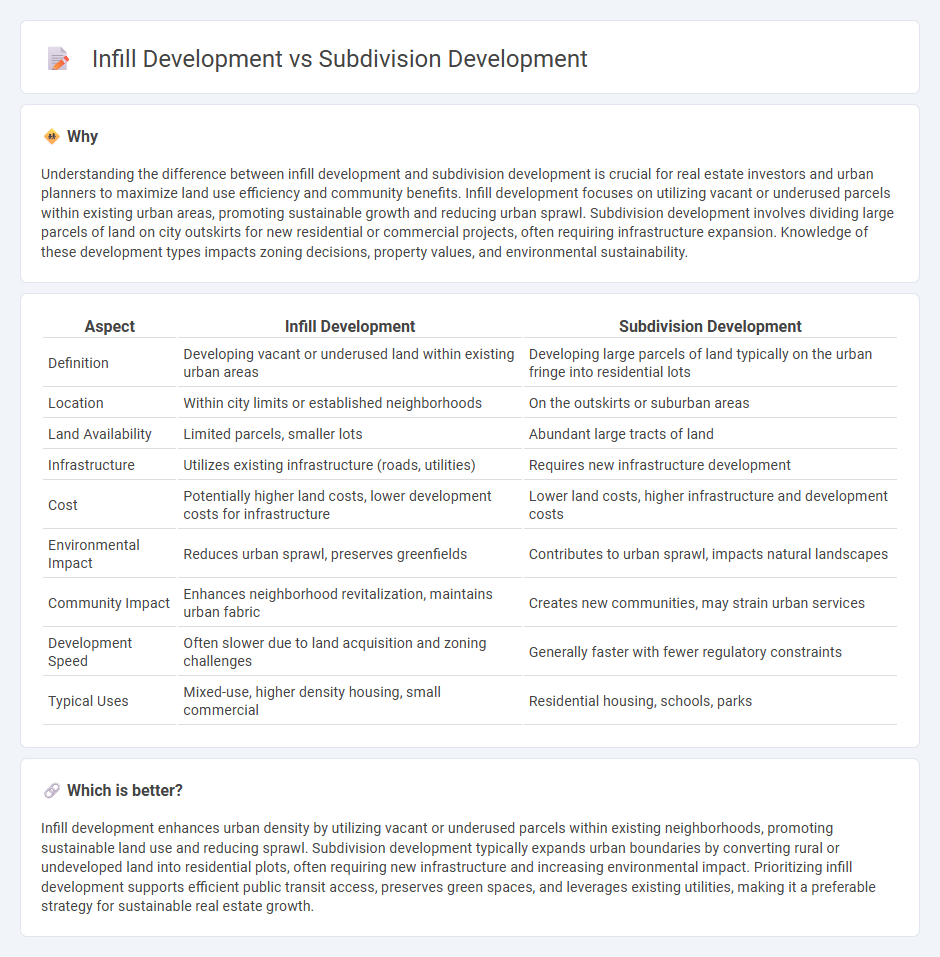
Infill development focuses on utilizing vacant or underused parcels within existing urban areas to increase density and optimize land use, promoting walkability and reducing urban sprawl. Subdivision development involves dividing larger land parcels on the urban fringe into smaller lots for new residential neighborhoods, typically expanding city boundaries and infrastructure. Explore more about how each approach impacts community growth and sustainability.
Why it is important
Understanding the difference between infill development and subdivision development is crucial for real estate investors and urban planners to maximize land use efficiency and community benefits. Infill development focuses on utilizing vacant or underused parcels within existing urban areas, promoting sustainable growth and reducing urban sprawl. Subdivision development involves dividing large parcels of land on city outskirts for new residential or commercial projects, often requiring infrastructure expansion. Knowledge of these development types impacts zoning decisions, property values, and environmental sustainability.
Comparison Table
| Aspect | Infill Development | Subdivision Development |
|---|---|---|
| Definition | Developing vacant or underused land within existing urban areas | Developing large parcels of land typically on the urban fringe into residential lots |
| Location | Within city limits or established neighborhoods | On the outskirts or suburban areas |
| Land Availability | Limited parcels, smaller lots | Abundant large tracts of land |
| Infrastructure | Utilizes existing infrastructure (roads, utilities) | Requires new infrastructure development |
| Cost | Potentially higher land costs, lower development costs for infrastructure | Lower land costs, higher infrastructure and development costs |
| Environmental Impact | Reduces urban sprawl, preserves greenfields | Contributes to urban sprawl, impacts natural landscapes |
| Community Impact | Enhances neighborhood revitalization, maintains urban fabric | Creates new communities, may strain urban services |
| Development Speed | Often slower due to land acquisition and zoning challenges | Generally faster with fewer regulatory constraints |
| Typical Uses | Mixed-use, higher density housing, small commercial | Residential housing, schools, parks |
Which is better?
Infill development enhances urban density by utilizing vacant or underused parcels within existing neighborhoods, promoting sustainable land use and reducing sprawl. Subdivision development typically expands urban boundaries by converting rural or undeveloped land into residential plots, often requiring new infrastructure and increasing environmental impact. Prioritizing infill development supports efficient public transit access, preserves green spaces, and leverages existing utilities, making it a preferable strategy for sustainable real estate growth.
Connection
Infill development and subdivision development are connected through their roles in urban growth and land use optimization. Infill development focuses on utilizing vacant or underused parcels within existing urban areas, promoting density and infrastructure efficiency. Subdivision development typically involves subdividing larger tracts of land on urban peripheries to create new residential or commercial lots, complementing infill strategies by balancing expansion and revitalization.
Key Terms
Subdivision Development:
Subdivision development involves transforming large parcels of land, typically in suburban or rural areas, into smaller lots for residential or commercial use, emphasizing planned neighborhoods with infrastructure like roads and utilities. This method supports urban expansion, catering to growing populations and often incorporates zoning regulations to shape land use and density. Explore the specific benefits and strategies of subdivision development to optimize land utilization and community planning.
Zoning Regulations
Subdivision development involves creating new residential areas by dividing large tracts of land into smaller lots, typically governed by zoning regulations that emphasize minimum lot sizes, density limits, and infrastructure requirements. Infill development focuses on redeveloping vacant or underutilized parcels within established urban zones, where zoning ordinances often prioritize compatibility with surrounding land uses, height restrictions, and parking mandates. Explore detailed zoning guidelines and their impact on urban growth by learning more about these development types.
Plat Map
Subdivision development involves dividing a large tract of land into smaller lots, often requiring a new plat map to outline streets, utilities, and parcel boundaries. Infill development focuses on utilizing vacant or underused parcels within existing urban areas, typically requiring an updated plat map to reflect alterations within established infrastructure. Explore further to understand how plat map differences impact zoning and infrastructure planning in both development types.
Source and External Links
Subdivision Development: Process and Benefits - Discusses the comprehensive process of subdivision development, including planning, zoning, infrastructure, and environmental considerations to create sustainable communities.
Subdivision Plan and Design - Layout and Site Planning - Outlines the necessary steps in subdivision design, including land surveys, plot plans, and potential zoning changes.
Understanding the Subdivision Process in California - Breaks down the key steps and regulations involved in the subdivision process in California, including formal applications, environmental reviews, and public hearings.
 dowidth.com
dowidth.com